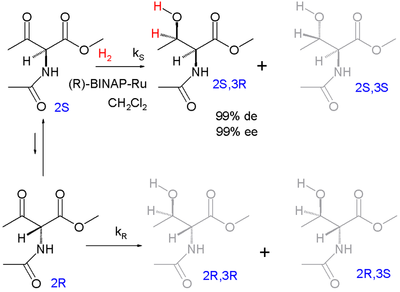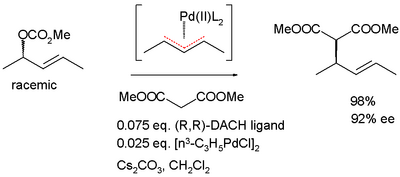Kinetic resolution
In kinetic resolution, two enantiomers show different reaction rates in a chemical reaction, thereby creating an excess of the less reactive enantiomer.[1] This excess goes through a maximum and disappears on full completion of the reaction. Kinetic resolution is a very old concept in organic chemistry and can be used in the organic synthesis of chiral molecules. It has been surpassed by other methods.
Kinetic resolution was first observed by Marckwald and McKenzie in 1899[2] in the esterification reaction of racemic mandelic acid with optically active (-)-menthol to a pair of diastereomeric esters.
In this reaction. the (R)-enantiomer of mandelic acid displays the higher reaction rate and, with incomplete conversion, the reaction mixture becomes enriched in (S)-mandelic acid. Full hydrolysis of the incomplete esterification mixture gives an excess of (R)-mandelic acid. Taking the reaction to 100% completion will again produce equal amounts of both esters.
Dynamic kinetic resolution
Dynamic kinetic resolution (DKR) is when the starting material can racemise under the reaction conditions, since this process is an equilibrium, with the faster reacting enantiomer being continually removed from the system, the major product of the reaction can exceed the previous maximum yield of 50%. DKR provides the possibility of up to 100% yield, provided the racemisation is much faster than the irreversible reaction. The observed dynamics are based on the Curtin-Hammett principle. In order to distinguish this process from classic resolution (which strictly speaking it is not), the term dynamic kinetic asymmetric transformation (DYKAT) has been introduced.[3]
One of the earliest demonstrations of this method[4] is an adaptation of the Noyori asymmetric hydrogenation by Ryōji Noyori:
The enantiomers interconvert through their common enol. The ultimate reaction product is the protected syn adduct l-threonine (2S,3R) with 99% diastereomeric excess (preference for the syn diastereomeric pair and not the anti pair) and 99% enantiomeric excess (preference for 3R product within the syn pair).
One study examined the biocatalytic acetylation of a racemic 8-aminotetrahydroquinoline 1 with Candida antarctica[5] Lipase B:
The enzyme only converts the R-enantiomer and, in regular kinetic resolution, a 50:50 mixture of retained (S)-amine 2 and (R)-acetamide 3 is obtained. However, the amine is racemized, thus increasing the yield of the acetamide beyond 50% and turning the process into a DKR one. The compound believed to be responsible for the racemization path is the ketone A, formed in catalytic quantities from the amine by action of the same enzyme and a catalytic amount of water. The ketone is able to form the racemic enamine 3 which can be hydrolyzed back to the amine.
In a second manifestation of the DKR method, both enantiomers of a racemic pair form a prochiral intermediate or a meso compound. An example is the allylic asymmetric alkylation depicted below, which proceeds through a pseudo-meso palladium-allyl complex.[3][6]
Mutual and Parallel Kinetic Resolution
Mutual kinetic resolution (MKR) is the reaction between two sets of racemic compounds via a kinetic pathway. This kinetic resolution is described as "mutual" because of the mutual reaction between the two sets of racemates.
Parallel kinetic resolution (PKR) is much the same as mutual kinetic resolution except that, instead of using two sets of racemates, only one set of racemates is used and resolved using a quasi-enantiomeric mixture of reagents (quasi-enantiomers are not strictly enantiomers, but they behave as if they are). This methodology is employed to achieve chromatographic isolation of the constituent stereoisomers with relative ease.[7]
References
- ^ Asymmetric Synthesis of Natural Products, Ari Koskinen ISBN 0-471-93848-3
- ^ W. Marckwald, A. McKenzie, Ber. 1899
- ^ a b Palladium-Catalyzed Dynamic Kinetic Asymmetric Allylic Alkylation with the DPPBA Ligands Barry M. Trost and Daniel R. Fandrick Aldrichimica Acta 40, 3 , 2007 [1]
- ^ Stereoselective hydrogenation via dynamic kinetic resolution R. Noyori, T. Ikeda, T. Ohkuma, M. Widhalm, M. Kitamura, H. Takaya, S. Akutagawa, N. Sayo, T. Saito, and et al. J. Am. Chem. Soc.; 1989; 111(25) pp 9134 - 9135; doi:10.1021/ja00207a038
- ^ Spontaneous Enzymatically Mediated Dynamic Kinetic Resolution of 8-Amino-5,6,7,8-tetrahydroquinoline Jason B. Crawford, Renato T. Skerlj, and Gary J. Bridger, J. Org. Chem.; 2007; 72(2) pp 669 - 671; (Note) doi:10.1021/jo062037t
- ^ Reagents: DACH ligand, Allylpalladium chloride dimer, Caesium carbonate and Dimethyl malonate
- ^ J. Eames, Angew. Chem. Int. Ed. 2000, 39, 885 - 888.
Further reading
- Dynamic Kinetic Resolutions. A MacMillan Group Meeting. Jake Wiener Link
- Dynamic Kinetic Resolution:A Powerful Approach to Asymmetric Synthesis. Erik Alexanian Supergroup Meeting March 30, 2005 Link
- Dynamic Kinetic Resolution: Practical Applications in Synthesis. Valerie Keller 3rd-Year Seminar November 1, 2001 Link
- Industrial enzymatic resolution with standard hydrolytic bulk enzymes.. Article on industrial enzymatic resolution with standard hydrolytic bulk enzymes. Link




